Sixteen Nudes and a Shipwreck
by jlyle
Date: 2004-07-25
Diving the wreck of the S.S. Avalon and the
nudibranchs that make her a great place to dive. Okay, okay, so
I misspelled nudis…but you're the one who took the
bait!
July, 2004, approximately three quarters of a mile off Palos Verdes Peninsula, Southern California
The sky was overcast, lead gray; the
wind was calm; the surface of the Pacific Ocean was flat except for
a few long, heavy rollers from out of the West. George and I
back-rolled into the water off Scott and Margaret's Popeye
Maru, then we surfaced briefly for Scott to hand us our cameras
before heading down the anchor line. Visibility near the surface was
very poor, the remnants of a red tide colored the water like weak
café au lait. Dropping lower, we hit a thermocline, some
forty feet below the surface; and the temperature dropped at least
ten degrees into the low 50's. Below the thermocline, visibility
improved greatly, opening up to thirty feet or more, helped by an
upwelling of cold, clear, nutrient rich water from the nearby
Redondo Canyon. Did I mention cold? I love my
dry-suit.
S.S. Virginia
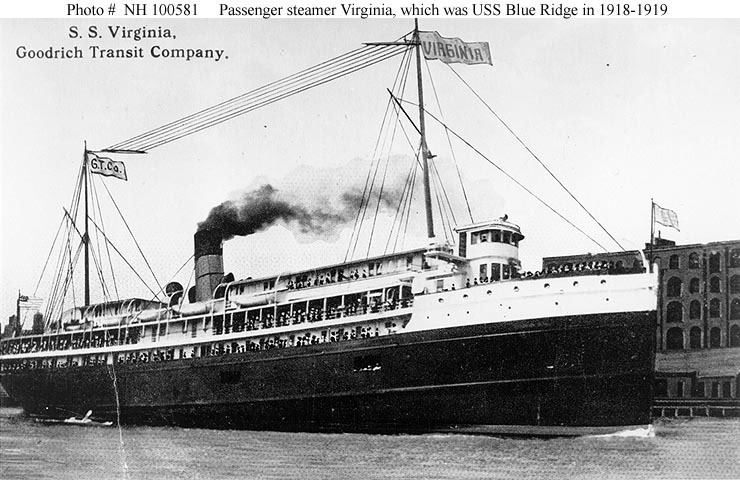
The bow of the S.S. Avalon (photo courtesy of Roger)
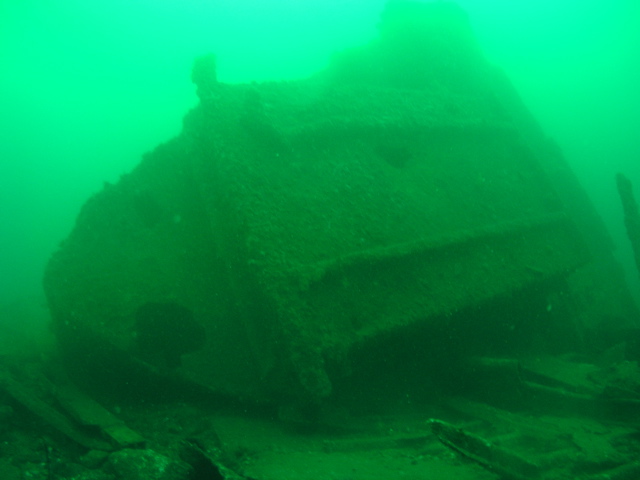
Our boat, the Popeye Maru, a 22' Arima Sea Legend Hard Top.

The rocky bottom, laid out
in low, parallel ridges at 70 – 75 feet below the surface, slowly
came into view as we drifted deeper. A dark shadow loomed at the
edge of visibility near the anchor chain on the rocks, the bow
section of the S.S. Avalon, still intact more than a century after
its construction and more than thirty years on the bottom of the
ocean. The bow that had been cut off the ship during World War I so
that she could pass through the St. Lawrence locks on her way to
war, arriving too late to help.
U.S.S. Blue Ridge

Me on the bow of the S.S. Avalon (photo courtesy of Roger).
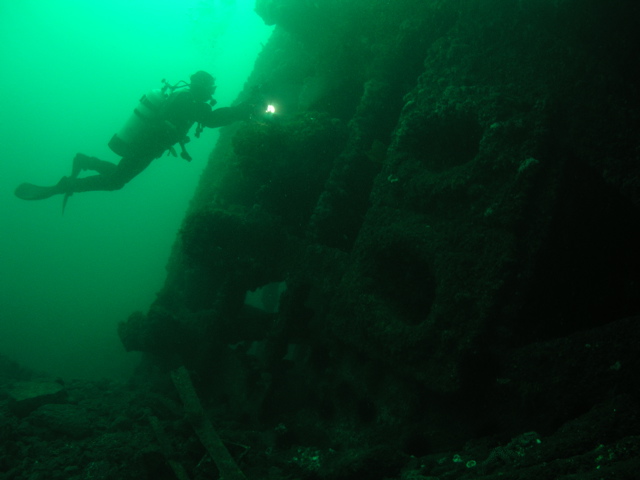
Leading away from the bow section, great iron plates, pieces of the ship's hull long since
collapsed, littered the bottom and faded off into the dark water. A
school of sargo stood sentinel near the bow; lingcod, Garibaldi,
cabezon guarded their nests; and groups of rockfish hovered here and
there waiting for some baitfish to make a fatal mistake. Small
strands of kelp clung to the rocky bottom, silently swaying in time
with the surge.
Lingcod (Ophiodon elongates)
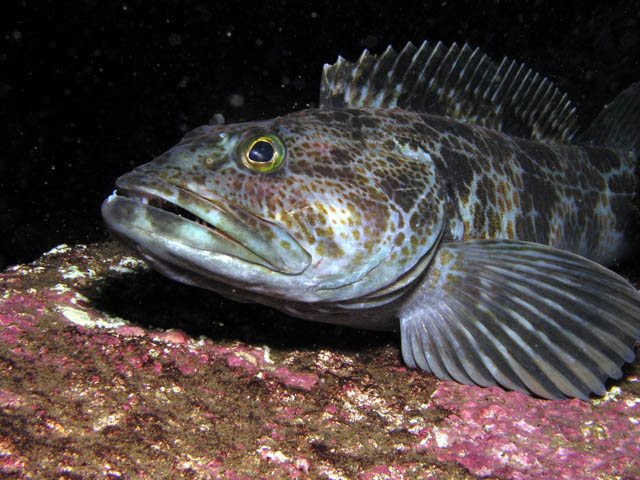
wreckmap
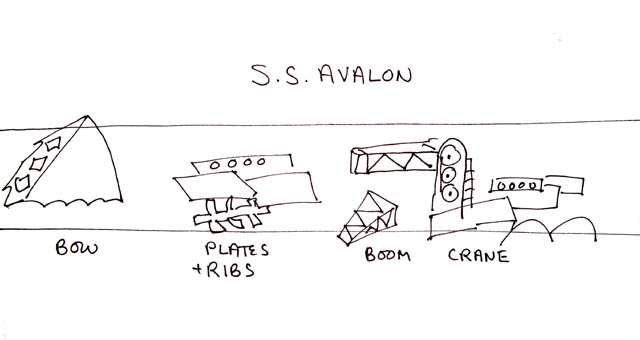
We added some air to our
dry-suits for warmth and buoyancy. Floating a few feet off the
bottom, we swam away from the bow, following the fallen sections of
hull. One steel plate was pierced along one edge with a row of large
dark holes where long-gone starboard portholes once rested. How many
travelers, first on the Great Lakes and, later, on their way to
Catalina Island, had looked out these same windows during the
ships's service as a passenger liner…how many
celebrities?
S.S. Avalon
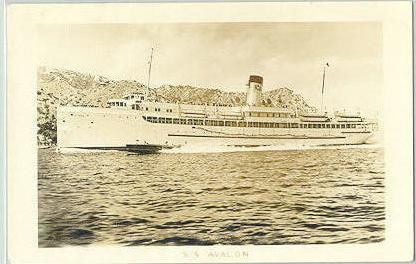
The wheels/tracks of the crane. (photo courtesy of Roger).
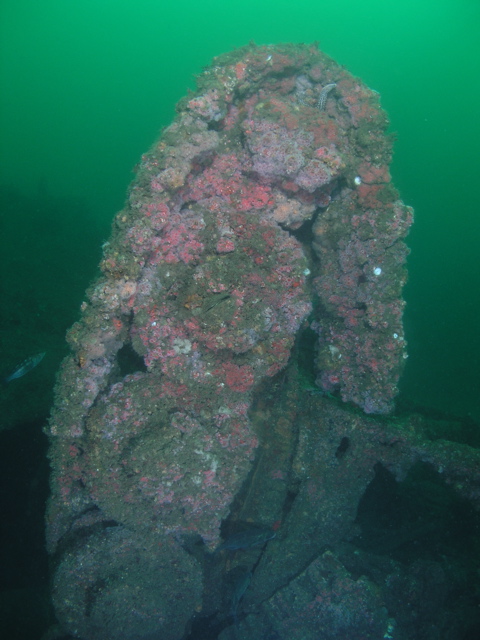
Further along, boom
sections from the crane, fitted to the stern when the S.S. Avalon
was converted into a salvage barge after being retired from her runs
to and from Catalina Island, lie in their final resting places next
to some large wheels and tracks sticking up from the bottom, covered
in Corynactis anemones - red, pink, and
yellow.
Corynactis californica

Periodically, we noticed flashes behind us, off in the gloom, Scott,
Margaret, and Roger's strobes firing.
Margaret

Painted greenling (Oxylebius pictus)
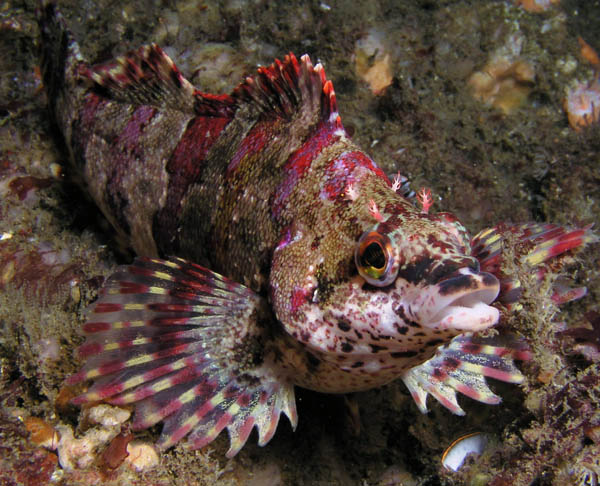
Finally, we came to the
end of the wreckage, a large bulkhead section with schools of fish
underneath and more steel plates pierced for the portholes below the
stern cabin.
Cabezon (Scorpaenichthys marmoratus)
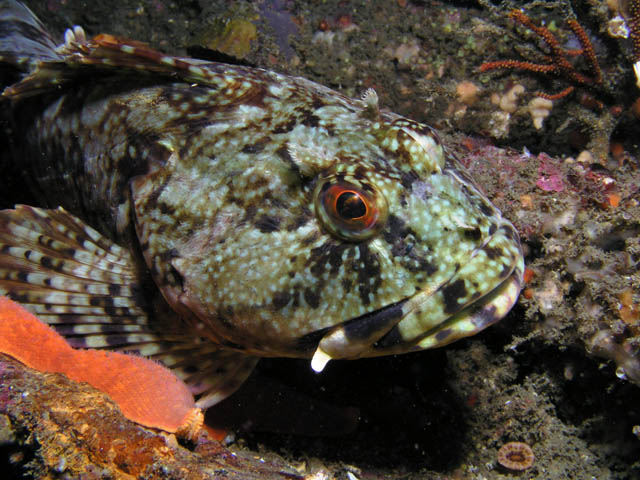
Photo taken by Margaret
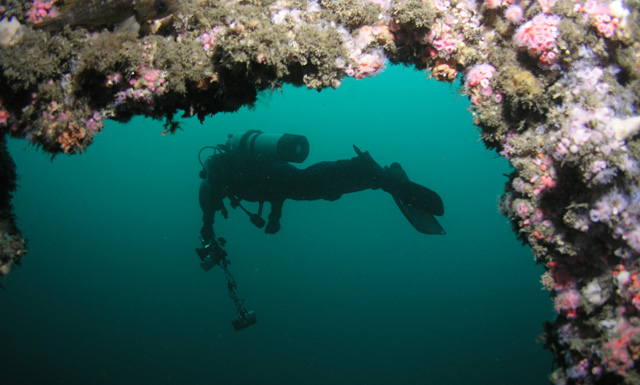
Half
way through our dive, we turned back towards the anchor, traversed
the wreck once more, made our way up the line to a safety stop at
fifteen feet and hung for a few minutes to off-gas some of the extra
nitrogen we had picked up during our sojourn on the bottom. A purple
jellyfish floated by. Life is good.
Purple jellyfish (Pelagia panopyra)

Sixteen nudes…er, make that nudis.
Margaret speculated that we had observed
ten species of opisthobranchs on the Avalon; I thought more, maybe
twelve. Roger said, three! After looking at our pictures and sorting
them out, we discovered that we had seen at least sixteen different
species of branchs on this one dive site! There are probably some
that we missed.
Berthella californica

Acanthadoris
hudsoni
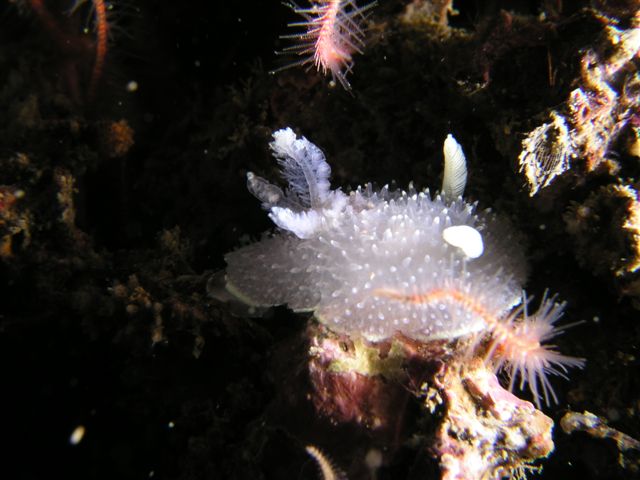
Acanthdoris lutea

Peltodoris nobilis previously known as Anisodoris nobilis
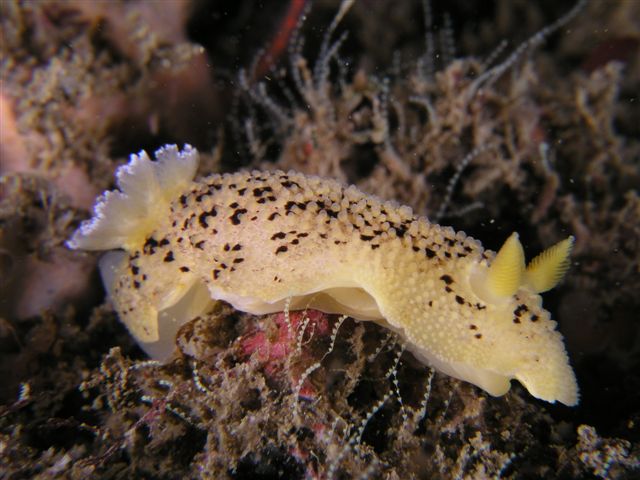
Cadlina limbaughorum
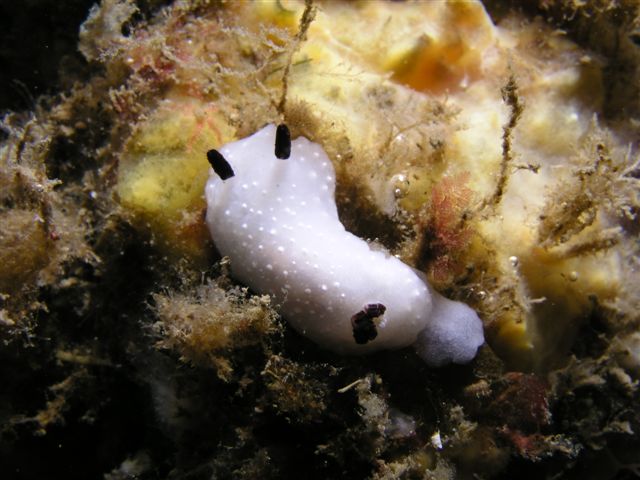
Triopha catalinae "Clown nudibranch"

Cadlina luteomarginata
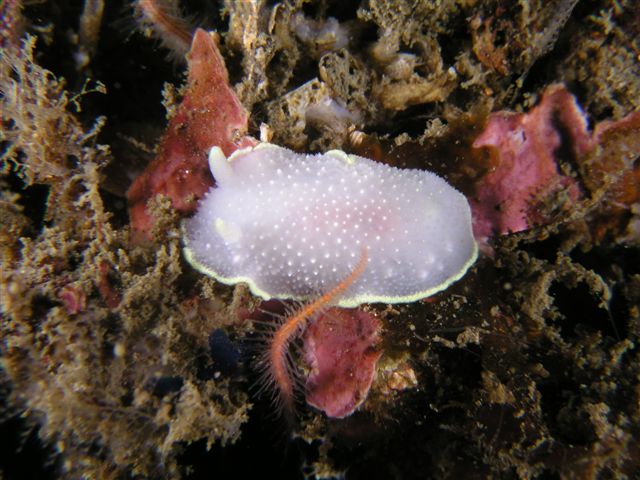
Peltodoris mullineri
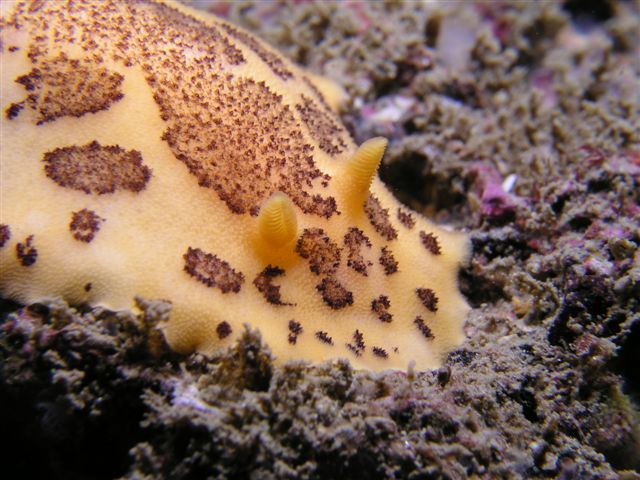
Flabellina
iodinea "Spanish Shawl," is the most common nudibranch at this
site. There are dozens of them on the bow of the wreck.

Diaulula sandiegensis
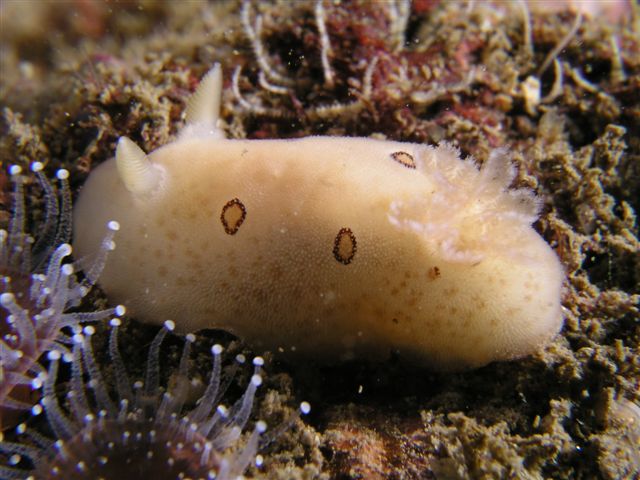
Polycera atra
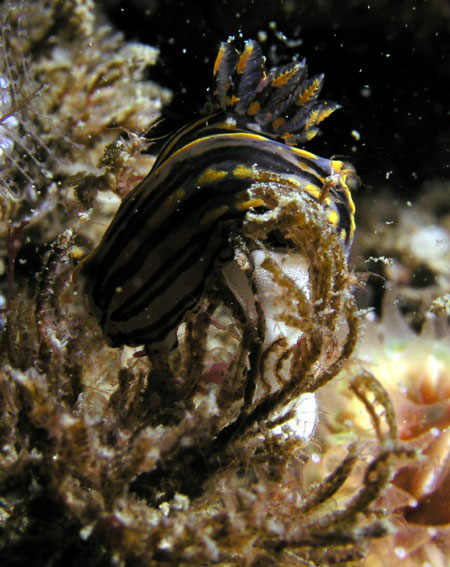
Dendrodoris fulva

another, slightly different Dendrodoris fulva
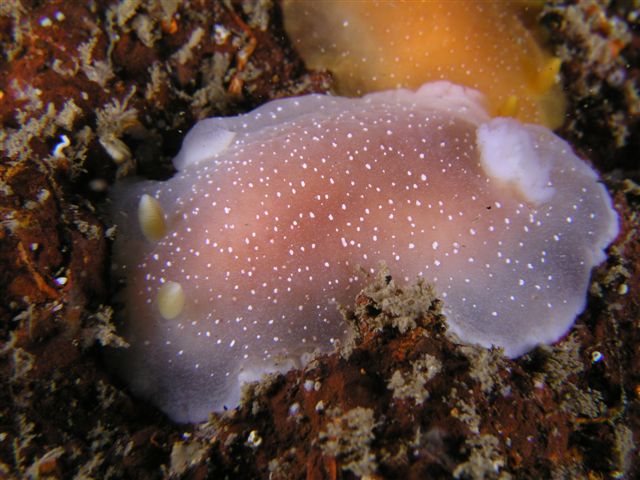
Flabellina trilineata photo taken by George (regtek)
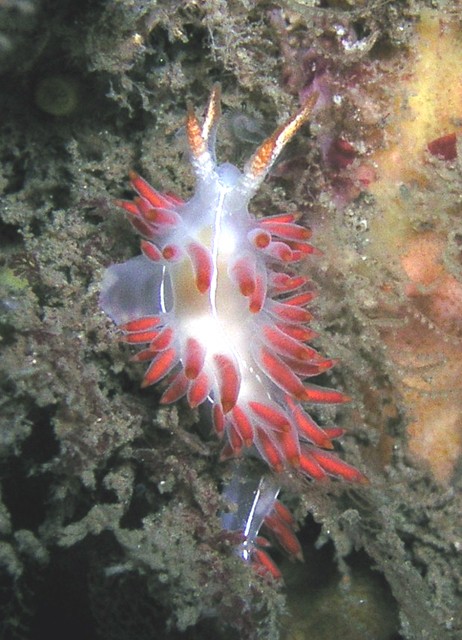
Facelina stearnsi
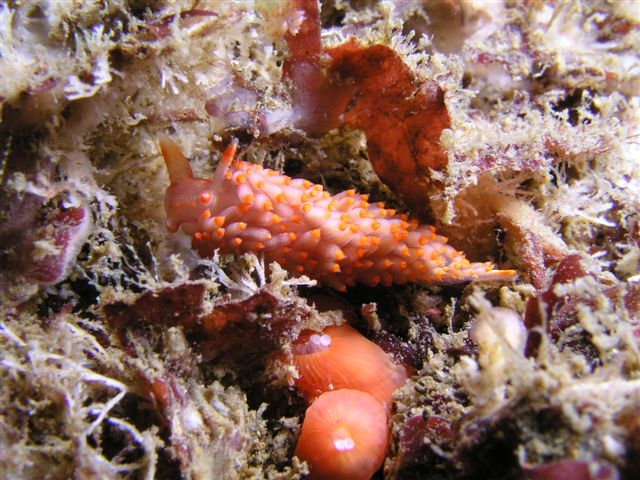
Doriopsilla albopunctata
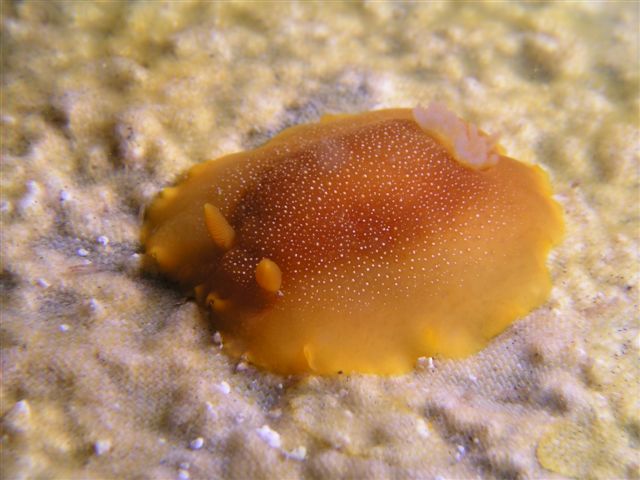
Hermissenda crassicornis "Horned nudibranch"
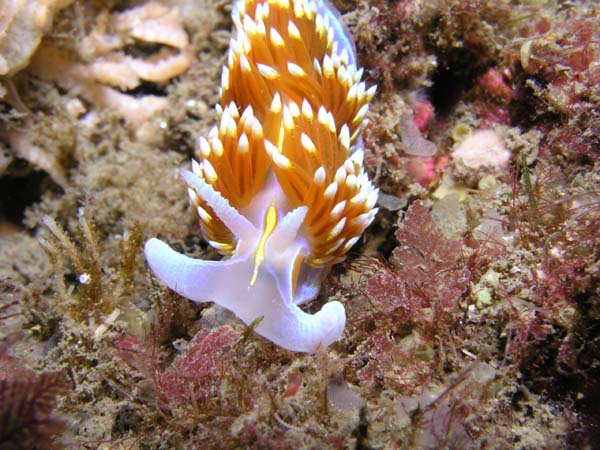
The future, nudibranch eggs.
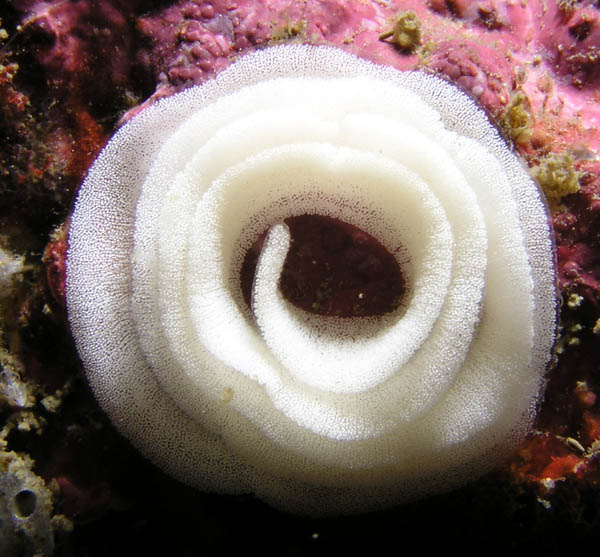
And, a seventeenth, unknown nudibranch! Cadlina sp?

The dive site:
Location: Southern California, three quarters of a
mile off Palos Verdes Point
Depth: 65-80 feet
The ship:
1,985 gross tons; 269 feet long, 38 foot beam
1891 – Built by the Globe Iron Works, Cleveland,
OH, and Christened the S.S. Virginia; she was operated by the
Goodrich Steam Co. carrying passengers between Chicago and Milwaukee
on the Great Lakes.
1918 – Requisitioned by the U.S.
Navy for use in WW I as a troop carrier and renamed U.S.S. Blue
Ridge, it was necessary to cut off her bow in order to get the
ship through the St. Lawrence locks.
1919 –
Decommissioned from the U.S. Navy (she never saw service in the war).
1919 – Purchased by Wilmington Transportation
Co. to ferry tourists to Santa Catalina Island, and renamed the
S.S. Avalon.
1951 – Retired from passenger service.
1960 – Sold for scrap to Everett Stotts, who
removed the superstructure and machinery.
1960 – Sold
one last time to Al Kidman, who converted her into a salvage barge
by cutting down the hull and placing a crane on her
stern.
1964 – S.S.Avalon sank, September 16, in a
storm when her anchor chains parted.
Today – The
Avalon broke in half when she sank and much of her hull has since
collapsed, littering the seafloor with steel plates. The bow section
of the ship is still more or less intact. Lying near the stern are
the tracks and arms of the crane that was fitted to her deck and
used in the salvage of the S.S. Dominator. Numerous schools of fish,
starfish, strawberry anemones, lobsters, and myriad other marine
animals now call her home.
Photo courtesy of Roger.

In addition to nudibranchs and fish, the wreck is also home to some
interesting small stuff:
Abalone (Haliotis sp)
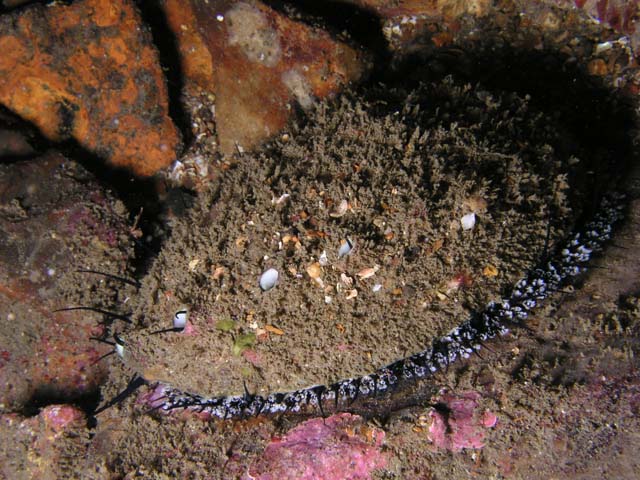
Coon stripe shrimp (Pandalus danae)

Blood star (Henricia leviuscula)

Chestnut cowry (Cypraea spadicea)
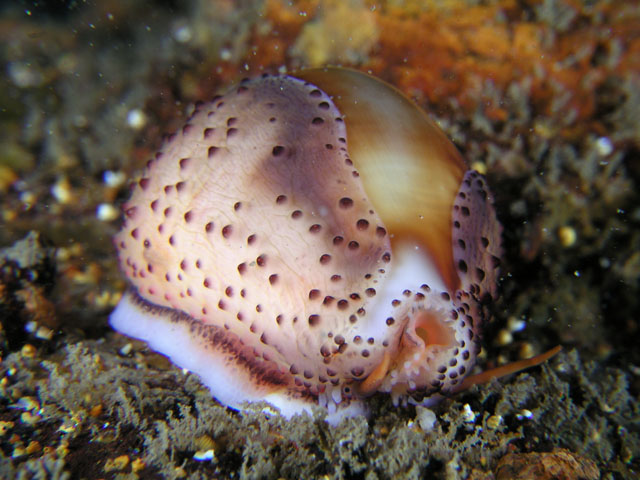
You
will find more pictures and information about the history and diving
the S.S. Avalon on these two websites:
A sister ship to the
Avalon was the S.S. Catalina.
Both were used to ferry tourists to and from Catalina Island and
were know as the Great White Steamers.
The California
Wreck Divers site has more pictures and history of the S.S.
Avalon.
We are lucky, here in Southern California, to have an
active diving publication, The California Diving News.
Their website has links to local dive operations, as well as a
calendar for most of the local dive boats.
Blue banded goby (Lythrupnus dalli)
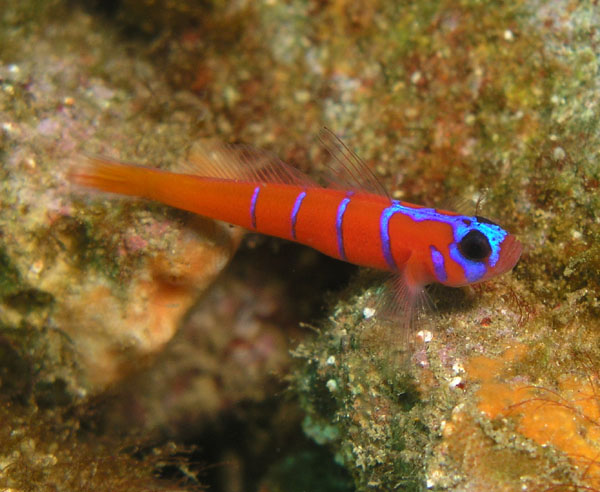
Diver.net bulletin board is a great
place to find out what's happening in the local dive community. The
homepage lists lots of useful links to local boats, weather
conditions, etc.
ladiver.com has links to every
conceivable web site that has anything to do with diving around Los
Angeles.
Two local dive boats that frequently take divers to
the wreck of the S.S. Avalon are the Island
Diver and the
Pacfic Star.
Garibaldi (Hypsypops rubicundus)

All pictures were taken
with Olympus c5050 cameras, Olympus PT-015 housings, and Ikelite
DS-125 strobes. The majority of the pictures are mine, but my
wonderful dive buddies, Roger, George, Scott and Margaret kindly
filled in the spaces.
DSAO,
Jim (jlyle)
Roger (rogerc)
Judy(judyc)
George (regtek)
Scott & Margaret (Seniorweeb)
A post script: We found another nudibranch
species on the wreck, Okenia rosacea (formerly called
Hopinsia rosacea)

Back To Home Page









































